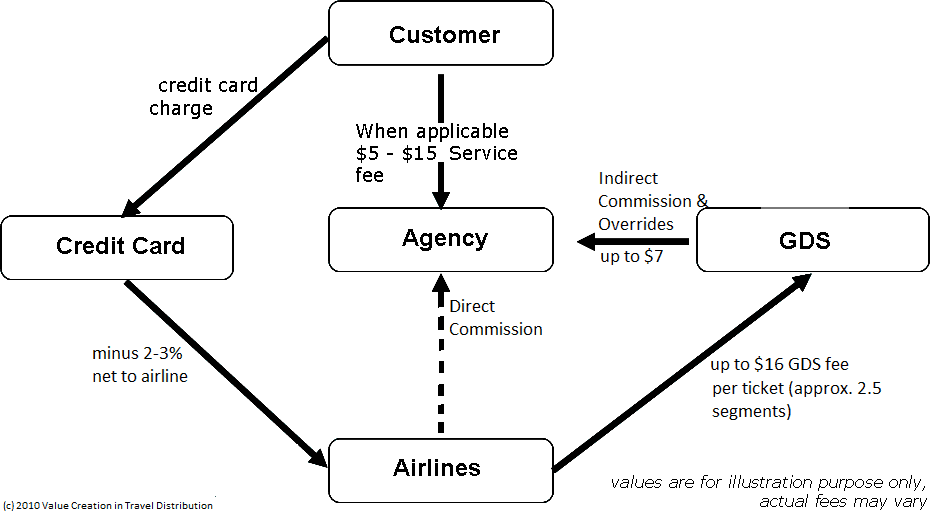I spoke a lot about Incentives, commission & overrides in my blog post about the US Airways vs. Sabre trial, where many numbers came to light and provided insight into the money flow here. But this time, I want to focus on what those numbers actually mean.
One model established in the airline industry is the incentive model. GDSs’ so-called segment fees for distribution are paid by the airline from the fee the traveler pays to it. GDSs generally pass on a part of this segment fee to the agencies which got the sale going. In some cases, the agency also demands a service fee directly from the customer and sometimes also receives additional commissions directly from the airline. Part of the amount for the ticket also goes to the credit card company if payment is not made by direct debit. Some airlines therefore also apply a credit card fee. The actual distribution of the fees and commissions to the parties involved (the settlement process) is generally handled via a clearing house (such as ARC or IATA).
How to Maximize Profit
The regular commission which GDSs pay an agency or TMC (the numbers where partly revealed in a lawsuit covered here) is straightforward per booking or per segment. However, it gets tricky when incentive overrides come into play. Commission overrides are an additional commission percentage paid when a certain volume level is achieved. I was amazed when one of our clients showed me the technology they put into place (using our multi-GDS engine underneath) to divert on a daily basis in which channels bookings were made in order to maximize their profit: The per-booking commission on one GDS was better than the other one, but they needed to achieve a certain number of bookings on the other GDS in order not to lose an incentive they had negotiated with the other GDS. It was amazing to see how they narrowed it down more or less to the last day of the year to make that one important booking which put them over the threshold so that all bookings made to date could receive an extra bonus.
One of Sabre’s annual reports for instance says: “Travel agency incentive consideration is a large portion of [GDS] expenses. The vast majority of incentive consideration is tied to absolute booking volumes based on transactions such as flight segments booked. Incentive consideration, which often increases once a certain volume or percentage of bookings is met, is provided in two ways, according to the terms of the agreement: (1) on a periodic basis over the term of the contract and (2) in some instances up front at the inception or modification of contracts; in this case the incentive consideration is capitalized and amortized over the expected life of the contract. Although this consideration has been increasing in real terms, growing in the low-single digits on a per booking basis in recent years, it has been relatively stable as a percentage of [GDS] revenue over the last five years, partially due to our focus on managing incentive consideration.”
Travel XML API
Are You the Perfect Revenue Manager?
Here is a little quiz for you to find out whether you are the perfect revenue manager (the quiz is purely fictive and has no relation to any real company incentives or overrides):
An agency makes 240 bookings a year. 40 bookings of this agency are made with airline A – all others are made with any airline bookable in a GDS. The agency has two GDS contracts (A & B) and gets the following commission and overrides:
- $1 for each booking in GDS A
- $1.10 for each booking in GDS A if the agency makes equal to or more than 100 bookings in GDS A
- $1.20 for each booking in GDS B but only for airline A throughout the year or any airline from December through April
- $0.80 for each booking in GDS B elsewise
Incentives are calculated per calendar year. Bookings are distributed evenly throughout the year. As a revenue manager of the agency, how can you maximize the agency’s profit and what will this profit be? Please provide your answer in the comments section.
Blog Series: Travel Technology for Dummies
- What Is Full Content?
- What Is a Booking Reference or PNR?
- What Is Overbooking?
- What Is a Passenger Service System (PSS)?
- What Are Booking, Waitlists, Tickets, Codeshare & Interlining?
- What Are Active and Passive Segments?
- What Are Incentives, Commissions & Overrides?
- What Is a ‘Married Segment’?
- Blockchain in Travel: All You Need to Know – for Now
- What Is the Difference Between Fares, Rates and Tariffs?
- What Is NDC?
- What Is Continuous Pricing?
- What Is Direct vs. Indirect Distribution?
Picture credit: Shutterstock






This Post Has 12 Comments
Good – pls. keep this informational – no advertising pls.! If you have anything to share that’s informative about the solution or in comparison to other solutions pls. do so …
We’ve just started using Avian.aero as our incentive management solution, they literally allow you to scan the contracts using their technology and by connecting to GDSs/BSP/ARC get the data on the screen. It’s pretty amazing…
Dear Mark,
Thanks for your question. I would assume, the details of such agreements and “what happens if..” is part of the agreement between the parties. I’m not sure I understand what you mean by a loss. I would say the commission/override is based on booked/traveled PNRs and that number cannot be negative.
Thanks,
Michael
If you are on override commission, and the company gets a loss or a negative in a certain month, do you get deduction on your wage for the negative sales for the period?
To my understanding… override is an incentive to be given for a profitable period… not for the company to take from the sales agent if the sales for the period is at a negative or a loss.
You are more than welcome. This may also be interesting as the money flow may change https://www.travel-industry-blog.com/travel-technology/fares-rates-and-tariffs/ due to https://www.travel-industry-blog.com/travel-industry/ndc/.
Thanks for the reply. I was missing the override bonus. the best revenue that I could made was:
100 booking on GDS A @$1.00 + 100 booking (dec-apr: 20×5) on GDSB @1.20+40 booking on GDS B @ 1.20
$100+ $120+$48 =$268
I will read on override commission. Thanks once again!
Ok, spoiler alert – here is the solution:
240 bookings total per year means 20 bookings per month on average.
Dec-Apr: all 20 bookings are made in GDS-B – meaning 5 months x 20 bookings x $1.20 = $120
May-Nov: all 40 bookings for Airline A need to be made during this time frame and on GDS B to maximize profit, so that you can get 40 bookings x $1.20 = $48. The remaining 100 bookings are made on GDS A, which also secures the $0.10 per booking in override bonus – hence 100 bookings x $1.10 = $110.
In summary: $120 + $48 + $110 = $278.
This means, within your booking tool, you need to steer all your travelers to book airline A on GDS B during the months of May-Nov. – something you can only do with an individualized tool such as https://www.pass-consulting.com/en/software-consulting/online-booking-tool/.
How $278 are you considering 190 bookings to be made in GDS B @1.20 (assuming 40 booking for airline A and 150 booking made from dec to april in gds B) and remaining 50 bookings in GDS A for the rest of the months?
Not bad, but you can even get up to $278!
258 will be the incentive
Dear OLEKSANDR,
It sounds about right. So, with the example (‘240 bookings a year. 40 bookings of this agency are made with airline A – all others are made with any airline bookable in a GDS’), what would be the actual $ amount of incentive of this agency that year?
Good job!
Thanks
The solution for the task.
$1 for each booking in GDS A
$1.10 for each booking in GDS A if the agency makes more than 100 bookings in GDS A
$1.20 for each booking in GDS B but only for airline A throughout the year or any airline from December through April
$0.80 for each booking in GDS B elsewise.
From Jan to Apr:
– book all airlines in GDS B
From May to Nov:
– book all airlines in GDS A except airline A
– book Airline A in GDS B
Dec:
While ( GDS A total bookings <=100) {
Book all airlines ex. Airline A in GDS A
book Airline A in GDS B
}
Book all airlines in GDS B
Book Airline A in GDS B
Alternative for Dec in case we are behind the total bookings for GDS A:
While ( GDS A total bookings that’s what changed to GDS A
}
Book all airlines in GDS B
Book Airline A in GDS B